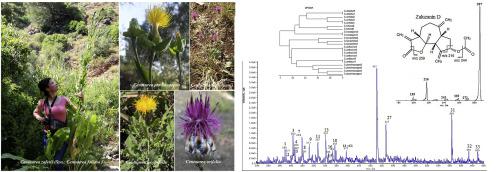当前位置:
X-MOL 学术
›
Biochem. Syst. Ecol.
›
论文详情
Our official English website, www.x-mol.net, welcomes your feedback! (Note: you will need to create a separate account there.)
Specialized natural product analysis and chemophenetics of some Turkish endemic Centaurea L. (Asteraceae) taxa by electrospray ionization mass spectrometry fingerprinting and liquid chromatography-tandem mafss spectrometry
Biochemical Systematics and Ecology ( IF 1.6 ) Pub Date : 2020-08-01 , DOI: 10.1016/j.bse.2020.104079 Yelda Güzel
Biochemical Systematics and Ecology ( IF 1.6 ) Pub Date : 2020-08-01 , DOI: 10.1016/j.bse.2020.104079 Yelda Güzel

|
Abstract Specialized natural product analysis of six Turkish endemic and two narrowly distributed Centaurea L. taxa was performed via electrospray ionization mass spectrometry (ESI-MS) fingerprinting and liquid chromatography-tandem mass spectrometry (LC-MS/MS), which is an effective methodology that is widely used for fast screening of complex natural mixtures such as food extracts, but not has not been used as commonly for plant chemophenetics. This method is preferable when it is aimed to compare a large number of plant extracts for chemophenetic purposes and when it is difficult to provide equally good chromatographic separation in all of the extracts. ESI-MS shows the major compounds in fingerprinting extracts. LC-MS/MS provides identification according to fragmentation with the advantage of MS/MS, and validation can be performed in selected reaction monitoring (SRM) mode with simultaneous precursor and product ion scans. Herein, sixteen flavones, four flavonols, four flavanones, two lignans, three sesquiterpene lactones, and four phenolic acids, a total of thirty three substances, were identified tentatively or unambiguously from the extracts. It was concluded that ESI-MS fingerprinting is a suitable method for plant chemophenetics when coupled and validated with LC-MS/MS. Moreover, it was concluded that sesquiterpene lactones, lignans, and flavonoids are suitable for taxonomic purposes in Centaurea owing to species-specific metabolite profiles.
中文翻译:

通过电喷雾电离质谱指纹图谱和液相色谱-串联 Mafss 光谱法对一些土耳其地方性 Centaurea L.(菊科)分类群进行专业的天然产物分析和化学表观分析
摘要 通过电喷雾电离质谱 (ESI-MS) 指纹图谱和液相色谱-串联质谱 (LC-MS/MS) 对六种土耳其特有种和两种分布较窄的 Centaurea L. 分类群进行了专业的天然产物分析,这是一种有效的方法。广泛用于快速筛选复杂的天然混合物,如食品提取物,但尚未广泛用于植物化学表观。当旨在比较大量植物提取物用于化学表型目的并且难以在所有提取物中提供同样良好的色谱分离时,该方法是优选的。ESI-MS 显示指纹提取物中的主要化合物。LC-MS/MS 利用 MS/MS 的优势根据碎片进行鉴定,验证可以在选择反应监测 (SRM) 模式下进行,同时进行母离子和产物离子扫描。在此,从提取物中初步或明确地鉴定了十六种黄酮、四种黄酮醇、四种黄烷酮、两种木脂素、三种倍半萜内酯和四种酚酸,总共三十三种物质。结论是,当与 LC-MS/MS 耦合和验证时,ESI-MS 指纹图谱是一种适合植物化学表观的方法。此外,结论是倍半萜内酯、木脂素和黄酮类化合物由于具有物种特异性的代谢物特征而适用于 Centaurea 中的分类学目的。从提取物中初步或明确地鉴定出四种酚酸,共 33 种物质。结论是,当与 LC-MS/MS 耦合和验证时,ESI-MS 指纹图谱是一种适合植物化学表观的方法。此外,结论是倍半萜内酯、木脂素和黄酮类化合物由于具有物种特异性的代谢物特征而适用于 Centaurea 中的分类学目的。从提取物中初步或明确地鉴定出四种酚酸,共 33 种物质。结论是,当与 LC-MS/MS 结合并验证时,ESI-MS 指纹图谱是一种适合植物化学表观学的方法。此外,结论是倍半萜内酯、木脂素和黄酮类化合物由于具有物种特异性的代谢物特征而适用于 Centaurea 中的分类学目的。
更新日期:2020-08-01
中文翻译:

通过电喷雾电离质谱指纹图谱和液相色谱-串联 Mafss 光谱法对一些土耳其地方性 Centaurea L.(菊科)分类群进行专业的天然产物分析和化学表观分析
摘要 通过电喷雾电离质谱 (ESI-MS) 指纹图谱和液相色谱-串联质谱 (LC-MS/MS) 对六种土耳其特有种和两种分布较窄的 Centaurea L. 分类群进行了专业的天然产物分析,这是一种有效的方法。广泛用于快速筛选复杂的天然混合物,如食品提取物,但尚未广泛用于植物化学表观。当旨在比较大量植物提取物用于化学表型目的并且难以在所有提取物中提供同样良好的色谱分离时,该方法是优选的。ESI-MS 显示指纹提取物中的主要化合物。LC-MS/MS 利用 MS/MS 的优势根据碎片进行鉴定,验证可以在选择反应监测 (SRM) 模式下进行,同时进行母离子和产物离子扫描。在此,从提取物中初步或明确地鉴定了十六种黄酮、四种黄酮醇、四种黄烷酮、两种木脂素、三种倍半萜内酯和四种酚酸,总共三十三种物质。结论是,当与 LC-MS/MS 耦合和验证时,ESI-MS 指纹图谱是一种适合植物化学表观的方法。此外,结论是倍半萜内酯、木脂素和黄酮类化合物由于具有物种特异性的代谢物特征而适用于 Centaurea 中的分类学目的。从提取物中初步或明确地鉴定出四种酚酸,共 33 种物质。结论是,当与 LC-MS/MS 耦合和验证时,ESI-MS 指纹图谱是一种适合植物化学表观的方法。此外,结论是倍半萜内酯、木脂素和黄酮类化合物由于具有物种特异性的代谢物特征而适用于 Centaurea 中的分类学目的。从提取物中初步或明确地鉴定出四种酚酸,共 33 种物质。结论是,当与 LC-MS/MS 结合并验证时,ESI-MS 指纹图谱是一种适合植物化学表观学的方法。此外,结论是倍半萜内酯、木脂素和黄酮类化合物由于具有物种特异性的代谢物特征而适用于 Centaurea 中的分类学目的。


























 京公网安备 11010802027423号
京公网安备 11010802027423号